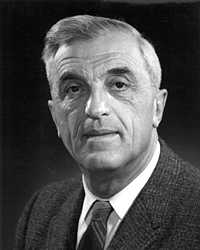Felix Bloch
| Felix Bloch | |
|---|---|
|
Felix Bloch (1905-1983) | |
| Born |
October 23, 1905 Zürich, Switzerland |
| Died |
September 10, 1983 (aged 77) Zürich, Switzerland |
| Citizenship | Swiss, American |
| Nationality | Swiss |
| Fields | Physics |
| Institutions |
University of California, Berkeley Stanford University |
| Alma mater | ETH Zürich and University of Leipzig |
| Doctoral advisor | Werner Heisenberg |
| Doctoral students | Carson D. Jeffries |
| Known for |
NMR Bloch wall Bloch's Theorem Bloch Function (Wave) Bloch sphere |
| Notable awards | Nobel Prize for Physics (1952) |
Felix Bloch (October 23, 1905 – September 10, 1983) was a Swiss physicist, working mainly in the U.S.[1]
Life and work
Bloch was born in Zürich, Switzerland to Jewish[2] parents Gustav and Agnes Bloch.
He was educated at the Cantonal Gymnasium in Zurich and at the Eidgenössische Technische Hochschule (ETHZ), also in Zürich. Initially studying engineering he soon changed to physics. During this time he attended lectures and seminars given by Peter Debye and Hermann Weyl at ETH Zürich and Erwin Schrödinger at the neighboring University of Zürich. A fellow student in these seminars was John von Neumann. Graduating in 1927 he continued his physics studies at the University of Leipzig with Werner Heisenberg, gaining his doctorate in 1928. His doctoral thesis established the quantum theory of solids, using Bloch waves to describe the electrons.
In 1940 he married Lore Misch.[3]
He remained in European academia, studying with Wolfgang Pauli in Zürich, Niels Bohr in Copenhagen and Enrico Fermi in Rome before he went back to Leipzig assuming a position as privatdozent (lecturer). In 1933, immediately after Hitler came to power, he left Germany because he was Jewish.[4] He emigrated to work at Stanford University in 1934. In the fall of 1938, Bloch began working with the University of California at Berkeley 37" cyclotron to determine the magnetic moment of the neutron.[5] Bloch went on to become the first professor for theoretical physics at Stanford. In 1939, he became a naturalized citizen of the United States. During WW II he worked on nuclear power at Los Alamos National Laboratory, before resigning to join the radar project at Harvard University.
After the war he concentrated on investigations into nuclear induction and nuclear magnetic resonance, which are the underlying principles of MRI.[6] In 1946 he proposed the Bloch equations which determine the time evolution of nuclear magnetization. He and Edward Mills Purcell were awarded the 1952 Nobel Prize for "their development of new ways and methods for nuclear magnetic precision measurements."[7] In 1954–1955, he served for one year as the first Director-General of CERN. In 1961, he was made Max Stein Professor of Physics at Stanford University.
At Stanford, he was the advisor of Carson D. Jeffries, who became a professor of Physics at the University of California, Berkeley.
He died in Zurich.[8]
See also
Footnotes
- ↑ Hofstadter, Robert (March 1984). "Obituary: Felix Bloch". Physics Today 37 (3): 115–116. Bibcode:1984PhT....37c.115H. doi:10.1063/1.2916128.
- ↑ Fraser, Gordon (2012). "Chapter 7". The Quantum Exodus. Oxford University Press. p. 182. ISBN 978-0-19-959215-9; hbk
- ↑ http://www.royalsoced.org.uk/cms/files/fellows/biographical_index/fells_indexp1.pdf
- ↑ "Bloch, Felix", Current Biography, H. W. Wilson Company, 1954. Accessed February 24, 2013. "Because of his Jewish faith, his position soon became uncomfortable and he went to Paris, where he lectured at the Institut Henri Poincaré."
- ↑ http://www.osti.gov/accomplishments/bloch.html
- ↑ Shampo, M A; Kyle R A (September 1995). "Felix Bloch--developer of magnetic resonance imaging". Mayo Clin. Proc. 70 (9): 889. doi:10.4065/70.9.889. PMID 7643644.
- ↑ - Sohlman, M (Ed.) Nobel Foundation directory 2003. Vastervik, Sweden: AB CO Ekblad; 2003.
- ↑ http://www.royalsoced.org.uk/cms/files/fellows/biographical_index/fells_indexp1.pdf
References
- November 1983. People and things: Felix Bloch. CERN Courier, 23(9), p. 386. Available at: https://cds.cern.ch/record/1730968
- "Nobel Prize for Physics, 1952". Nature 170 (4335): 911–912. 1952. Bibcode:1952Natur.170R.911.. doi:10.1038/170911b0.
- "Deputy Director-General: Prof. E. Amaldi". Nature 174 (4434): 774–775. 1954. Bibcode:1954Natur.174R.774.. doi:10.1038/174774c0.
- McGraw-Hill Modern Men of Science 1. McGraw-Hill. 1966. pp. 45–46. ISBN 978-0-07-045217-6.
- National Cyclopaedia of American Biography 61. James T. White & Co. 1984. pp. 310–312. ISBN 0-88371-040-4.
Further reading
External links
- Biography and Bibliographic Resources, from the Office of Scientific and Technical Information, United States Department of Energy
- http://nobelprize.org/physics/laureates/1952/bloch-bio.html
- http://www-sul.stanford.edu/depts/spc/xml/sc0303.xml
- Oral History interview transcript with Felix Bloch 14 May 1964, American Institute of Physics, Niels Bohr Library and Archives
- Oral History interview transcript with Felix Bloch 15 August 1968, American Institute of Physics, Niels Bohr Library and Archives
- Oral History interview transcript with Felix Bloch 15 December 1981, American Institute of Physics, Niels Bohr Library and Archives
- Felix Bloch Papers, 1931-1987 (33 linear ft.) are housed in the Department of Special Collections and University Archives at Stanford University Libraries
- National Academy of Sciences Biographical Memoir
- Felix Bloch Papers
| ||||||||||||||||||||||
|

